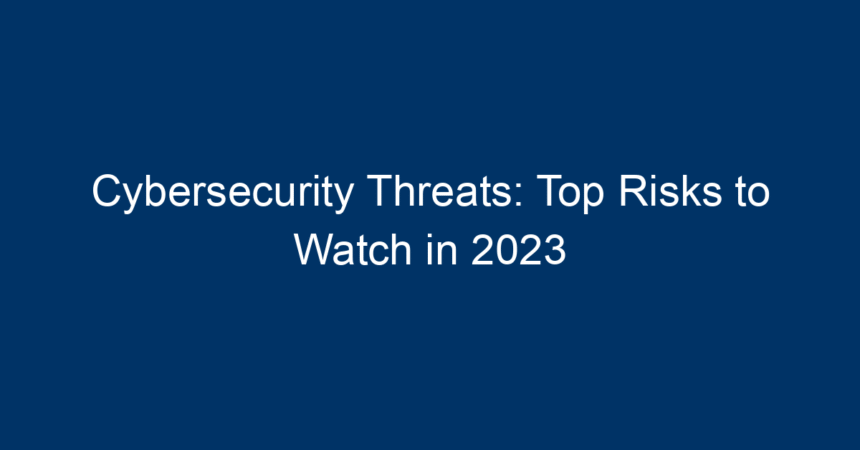As we navigate an increasingly digital landscape, the complexities of cybersecurity threats only continue to evolve. In 2023, businesses, governments, and individuals face rising risks from a variety of malicious actors, each armed with advanced techniques and tools. This article will explore the top cybersecurity threats to monitor this year, offering insights into their potential impact and how to combat them effectively.
Understanding Cybersecurity Threats
Before diving into specific threats, it’s essential to understand what cybersecurity threats are. These consist of any potential danger to information systems, networks, or devices that can lead to data breaches, system losses, or collateral damage. The methods used by cybercriminals are constantly evolving, making cybersecurity a perpetual challenge for organizations and end-users alike.
1. Ransomware Attacks
The Rise of Ransomware
Ransomware continues to be one of the most pressing cybersecurity threats in 2023. Cybercriminals exploit vulnerabilities in networks and endpoints to deploy malicious software that encrypts sensitive data. The attackers then demand a ransom, typically in cryptocurrency, to restore access.
Why It’s a Major Concern
Organizations of all sizes can fall victim to ransomware, and the financial implications can be staggering. In 2023, we see a shift in tactics where attackers are not only demanding ransoms but also threatening to sell or leak sensitive data, adding additional pressure on victims.
Protection Strategies
To mitigate the risk of ransomware:
- Regular Backups: Always maintain up-to-date backups to recover data without paying the ransom.
- Security Awareness Training: Train employees about phishing attacks and other vectors commonly used to deliver ransomware.
- Endpoint Protection: Invest in robust antivirus and endpoint detection solutions.
2. Phishing and Social Engineering
How Phishing Works
Phishing remains a favorite tactic used by cybercriminals, notably as it exploits human psychology. Attackers send seemingly legitimate emails or messages designed to trick individuals into providing sensitive information or installing malware.
Social Engineering Tactics
In 2023, social engineering has become more sophisticated, with attackers conducting extensive research on their targets to craft convincing messages. For example, Cybercriminals are increasingly utilizing platforms like LinkedIn and Facebook to gather information about potential victims and their colleagues.
Preventative Measures
To combat phishing attacks:
- Email Filtering: Use advanced email filtering technologies to catch fraudulent emails.
- Two-Factor Authentication: Implement two-factor authentication (2FA) to add an extra layer of security.
- Regular Training Sessions: Conduct training sessions to keep employees informed about the latest scams.
3. Internet of Things (IoT) Vulnerabilities
The Growing IoT Ecosystem
With the rise of smart devices, the Internet of Things (IoT) has expanded dramatically in the last few years. While these devices bring convenience, they also pose considerable cybersecurity threats.
Security Gaps
Many IoT devices lack robust security features and are often poorly configured. This creates vulnerabilities that cybercriminals can exploit, leading to potential breaches. In 2023, attackers may target IoT devices to create botnets used in larger attacks.
Solutions to Secure IoT
To protect IoT devices:
- Change Default Passwords: Always change default credentials to something stronger.
- Network Segmentation: Place IoT devices on a separate network to limit exposure.
- Regular Firmware Updates: Ensure that all devices are updated to the latest software versions, addressing vulnerabilities.
4. Cloud Security Threats
Migration to the Cloud
As more organizations migrate to cloud services, the attack surface expands, presenting new cybersecurity threats. Misconfigurations, insecure APIs, and data leaks are common issues faced in the cloud environment.
Major Risks
In 2023, cloud security breaches can lead to unauthorized data access or loss. Cybercriminals continuously look for misconfigured cloud storage services as a way to steal sensitive information or deploy malware.
Best Practices for Cloud Security
To fortify cloud security:
- Regular Audits: Conduct regular security audits to identify and rectify configuration issues.
- Data Encryption: Ensure data is encrypted both in transit and at rest.
- Access Management: Implement stringent access management policies to control who can access sensitive data.
5. Insider Threats
The Human Factor
While external threats often dominate discussions around cybersecurity, insider threats are equally significant. Employees or contractors can inadvertently or maliciously compromise security.
Identifying Insider Threats
In 2023, organizations need to be vigilant about insider threats, which can be challenging to detect. Malicious insiders may have knowledge of security protocols, making their actions particularly damaging.
Mitigation Techniques
To guard against insider threats:
- Behavior Monitoring: Implement behavior analytics solutions to detect anomalies in user activities.
- Access Controls: Restrict access to sensitive information to only those who need it.
- Exit Policies: Establish clear exit policies for departing employees to manage data access.
Conclusion: Staying Ahead of Cybersecurity Threats in 2023
As we continue through 2023, the landscape of cybersecurity threats is more challenging than ever. From ransomware and phishing attacks to IoT vulnerabilities and cloud security risks, understanding these challenges is critical for effective defense.
Actionable Insights
- Education is Key: Continuously educate employees about the evolving nature of cybersecurity threats.
- Invest in Technology: Utilize technologies such as AI and machine learning for threat detection and mitigation.
- Collaborate: Encourage collaboration among teams to share knowledge and innovate security strategies.
By prioritizing these actions, organizations can significantly reduce their risk of falling victim to cybersecurity threats in 2023. As threats continue to evolve, so too must our strategies for staying secure in the digital age.




